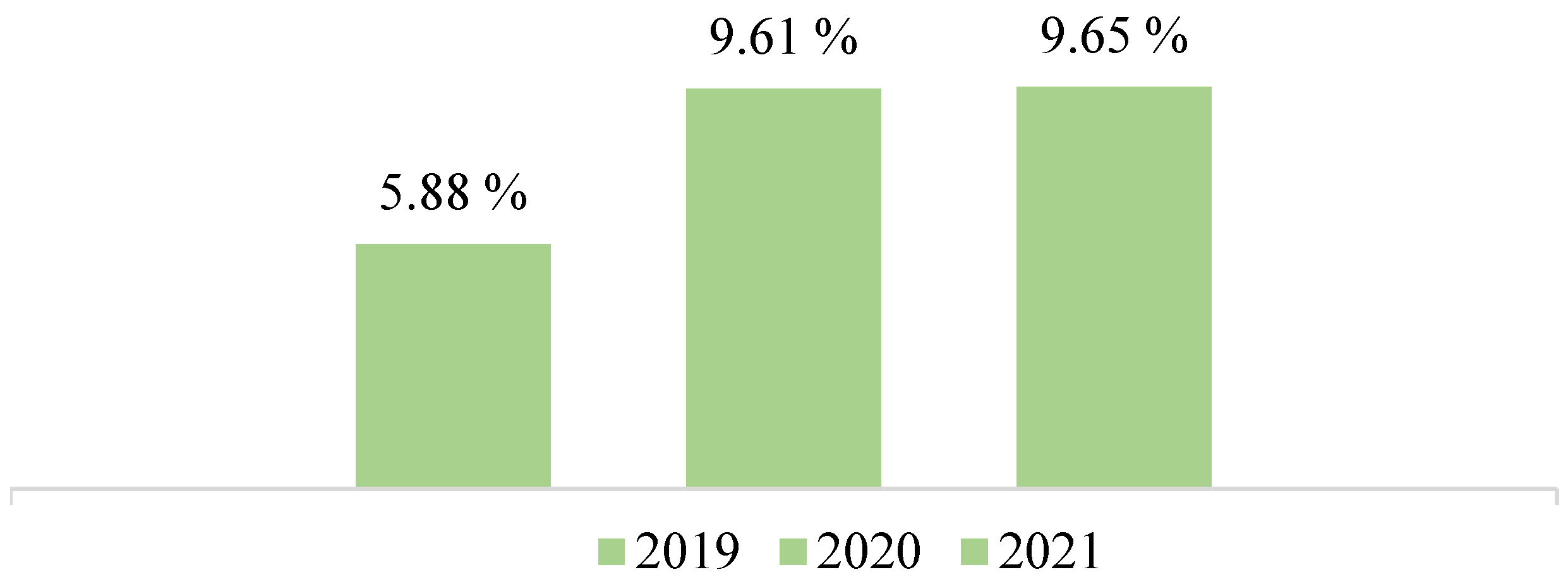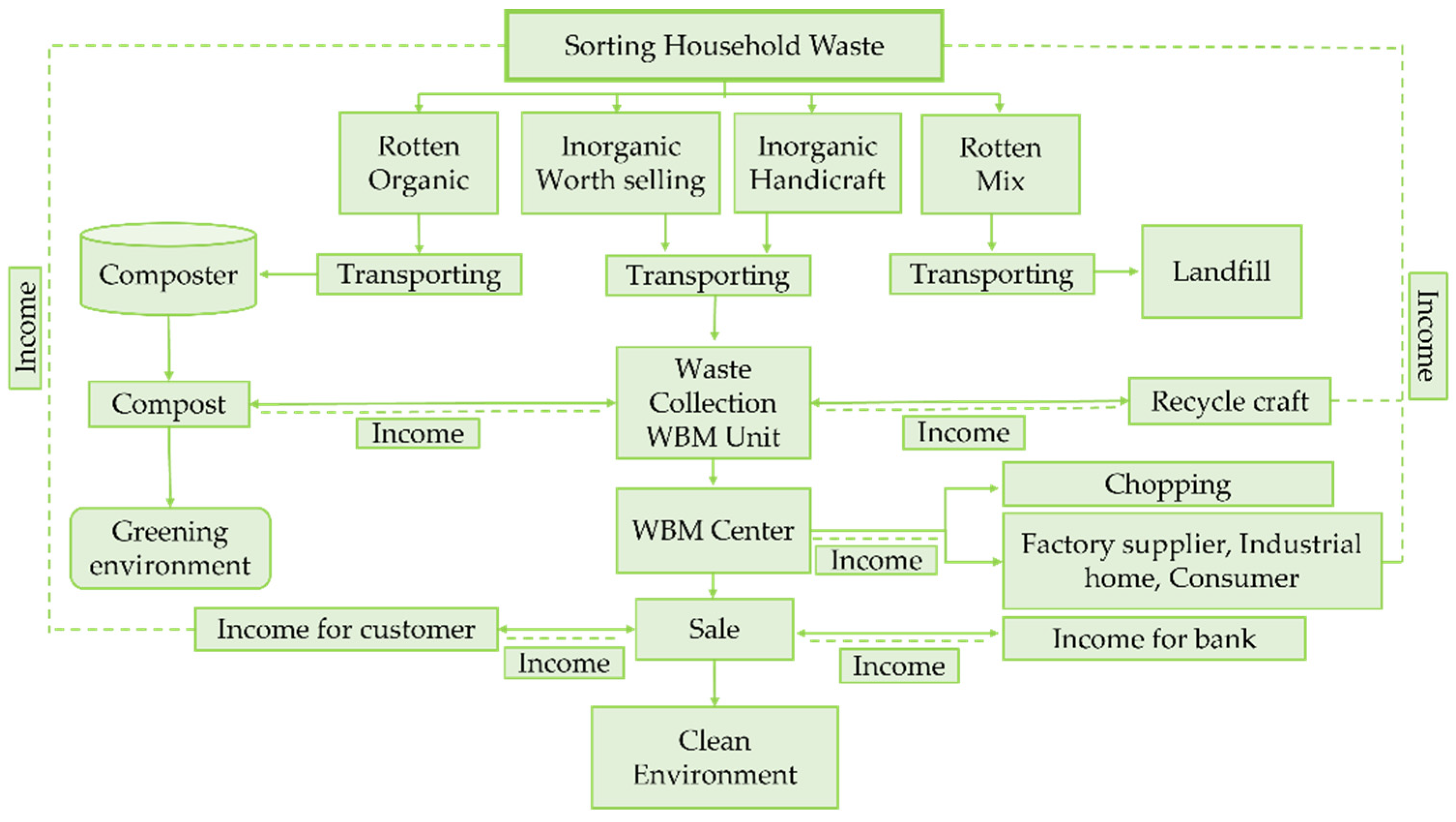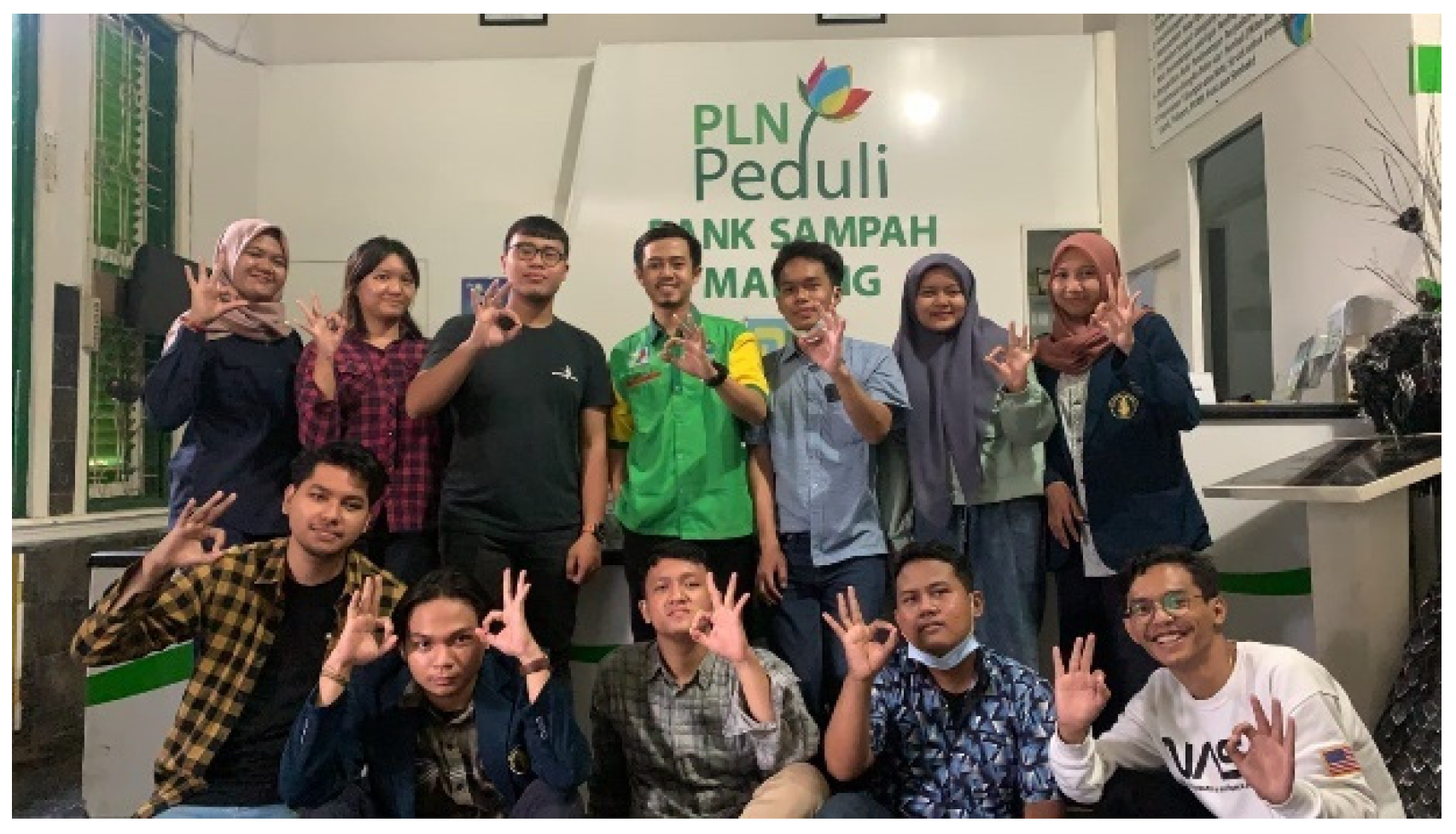Waste Bank-Socio-Economic Empowerment Nexus in Indonesia: The Stance of Maqasid al-Shariʻah
Abstract
:1. Introduction
2. Literature Review and Methods
2.1. The Waste Bank
2.2. Socio-Economic Empowerment
2.3. Maqasid al-Shariʻah
3. Methodology
4. Results and Discussion
4.1. Waste Bank of Malang: An Overview
4.2. The Mechanisms of Processing of WBM
4.3. The Analysis of Waste Bank of Malang from the Perspective of Maslahah
4.4. The Analysis of Waste Bank from the Perspective of Religion
4.5. The Analysis of Waste Bank from the Perspective of the Soul
4.6. The Analysis of Waste Bank from the Perspective of Intellect
4.7. The Analysis of Waste Bank from the Perspective of Offspring
4.8. The Analysis of Waste Bank from the Perspective of Wealth
4.9. The Contribution of Waste Bank to Socio-Economic Development of Malang
4.9.1. The Role of the Waste Bank in Empowering the Economy
- (a)
- Establishing partnerships between society’s components (individuals, communities, organizations, and schools) and waste banks means taking an active role in waste management.
- (b)
- The government’s synergy with waste banks leads to a clean environment and boosts income.
- (c)
- Collaborating with society, the government can improve human resources and raise public awareness about waste reduction.
- (d)
- Cooperation between all stakeholders (community, waste bank, and government) is essential for economic empowerment.
4.9.2. Economic Value of Waste Banks
4.9.3. The Financial Analysis of Waste Bank of Malang
4.9.4. The WBM Program for Empowering the Economy
- Wash coffee packs and related types of IDR 7.000 per kg.
- Wash oil pack and related types of IDR 700 per kg.
- Chopping IDR 12.000 per kg.
- Daily sewing IDR 27.000 per day.
- Wholesale IDR 2.000 to IDR 12.000 depending on the production type.
- Weaving IDR 5.500/100 packs.
- Sewing webbing IDR 3.000/100 packs.
5. Conclusions and Recommendations
Limitation of the Study and Suggestions for Future Research
Author Contributions
Funding
Institutional Review Board Statement
Informed Consent Statement
Data Availability Statement
Acknowledgments
Conflicts of Interest
Abbreviations
| CBSM | Central Bureau of Statistics of Malang or “Badan Pusat Statistik Kota Malang (BPS Kota Malang)” CBSM/BPS |
| CSR | Corporate Social Responsibility |
| MEFI | Ministry of Environment and Forestry of Indonesia |
| NPV | Net Present Value |
| WBM | Waste Bank of Malang |
| ZW | Zero Waste |
| 3Re | Reduce, Reuse, Recycle |
Appendix A
| Question (Q)1. How is the role of the waste bank in empowering the economy of the community? |
| Response: “The role of the waste bank for the society’s empowerment is increasing the communiti’s income when exchanging waste in the form of money collected in the account book owned by them, and also the community becomes aware of the importance of cleanliness and utilizing waste into economic value. Beside, it is to make the environment clean and toward sustainable development”. |
| Q2. How does waste bank affect socio-economic empowerment? |
| Response: “The respondance said that zero waste regulation can change the public’s perspective on the waste that has economic value. Some interviewees said that zero waste bank in Malang can provide alternative jobs and reduce unemployment in the city. They said that waste bank could assist and help their daily need as well as their business through saving and credit without interest. They added that the waste bank not only provides economic emowerment to the community but also that it provides education empowerment through waste recycling training, seminars, and others”. |
| Q3. What is the purpose, role and concept of waste bank based on Shari’ah? |
| Response: “The purpose of the waste bank in Malang is to anticipate the mountains of waste in the Supit Urang landfill. On the other side, establishing this waste bank aims to build public awareness in managing waste properly while campaigning to reduce, reuse, recycle. Therefore, the Malang city government decided to control waste management through Regulation No.10 of 2010 in Malang city. The Government’s role of Malang through the Malang City Environment Service assisted the waste bank by providing equipment like waste trucks, carts, plastic chopping machines, and the construction of warehouses. On the other side, Individuals and communities can establish a waste bank unit under the guidance of the waste bank center, therefore, can provide a new job and economic value from waste recycling. In ten years for development and assistance on waste management through waste banks, by the end of 2019, there were 270 waste bank units in Malang and provided part-time, full-time, and volunteer jobs. The basic principle of waste bank is to invite the community to reduce waste from the source, sort it from households and then sell/save it in a waste bank and have a shared slogan, change waste into rupiah, and turn problems into blessings.” “The concept of savings in waste bank is like the Shariʻah bank system; However, what is deposited is not the amount of money, but the waste and the savings without interest system, which is haram in Islam. When customers sell their waste, the waste bank will record the sales in a savings book provided by the waste bank. The deposit can depend on the contract or agreement between the customer and waste banker”. |
| Q4. What is the program of waste bank in empowering the economy? |
| Response: “The waste bank program in empowering the economy consits of deposit and credit, beside that it has educational empowerment through workshop, internship, comparative study, socialization, and recycling tryning”. “Waste sorting is very easy. Besides that, the waste can be deposited in a waste bank and get value in the form of money”. |
| Q5. What is the role of the waste bank in preserving the environment? |
| Response: “The main mission of this waste bank is reducing the amount of waste generated that is transported to the Final Processing Site (Supit urang), utilizing waste into useful goods with economic value, changing people’s behavior in managing waste properly and environmentally friendly”. |
| Q6. How is the impat of waste bank to the society? |
| Response: “Besides aiming to help the community’s economy, the existence of this waste bank improves people’s quality of life and creates a clean environment”. “This empowerment concept is very beneficial for the environment and a learning method for future generations to build sustainable development.” |
| Q7. How is the role of waste bank to the community? |
| Response: “Waste bank is managed using a system similar to banking which is carried out by volunteer officers. The main purpose of establishing a waste bank is to help handle waste processing and the next purpose of a waste bank is to make people aware of a healthy, neat and clean environment”. |
| Q8. How does the waste bank educate and empower the community? |
| Response: “Most interviewees respond positively and feel good with empowerment provided by WBM because they get insight and knowledge. Besides, the training, workshop and seminar are an essential aspect of increasing the community’s lack of awareness and improving the community’s skills”. |
| Q9. How does the waste bank implement the religious teaching and the transaction based on Shari’ah? |
| Response: “Transaction in waste bank applys Islamic finance such as the concept of savings and credit without intereset system that is prohibited in Islam thees contract similar with the transaction in Islamic bank like wadiah and qordul hasan contract. The rules of our waste bank also does not administer gharar and maisir as well as Selling when the Friday Adhan is called. Beside that, its purpose to assists the community especially the poor peaple to fulfiill their need”. |
| Q10. Where is the capital and income of waste bank from? Our waste bank get assistant from the Malang city government |
| Response:“The capital and income of waste bank assısted from Government, corporate social responsibility (CSR) of the State Electricity Company (PT. PLN), and other organizations”. |
| Q11. What are the advantages of deposit, and what is the role of a waste bank for your family? |
| Response: “Saving in a waste bank has many benefits, for example, making a clean environment, improving the awareness of the community to care about cleanliness, and returning the waste into economic value. The waste can be exchanged and saved for money. We are also learning how to sort the waste according to its type, so the price will be higher if we sort it by type”. “The existence of a waste bank can improve my family’s income, even though the money got is not much. I have extra income, such as paying for electricity, water, and school fees for my children”. |
| Q12. How much income do you earn from waste saving and for what do you spend its income? |
| Response: “I earn money from waste bank around 700–1000 thausand rupiah per month (Customer)”. “We get income around IDR 1.300.000 per month if we have many orders (Artisans)”. “It is enough to buy the household goods as well as for school fee” |
| Q13. What are the benefits of saving waste? |
| Response: Most respondents said that recycling training could open new opportunities for the community to create new jobs. Further, some of them said that it could advance the nation economically and reduce the number of unemployed. The interviewees’ customers stated that the recycling craft can improve little family’s income even though it is not much, for instance, for their children’s school fees, electric payment, and the cost of sick. |
| Q14. How many savings does waste bank provide and what are they? |
| Response: “There are fıve type of savıng in waste bank which are regular savings, education savings, groceries savings, environmental savings, and health insurance savings”. |
| Q15. How does profit sharing system apply in waste bank? |
| Response: “The profit sharing of waste bank here used the rule from Ministry of Environment and and Forestry of Indonesia which is 15% for the waste bank, and 85% for the customer. The profit sharing for customer is higher than waste bank because waste bank has supported by government and corporate social responsibility (CSR) objectives of the State Electricity Company (PT. PLN). This system also for encouraging the people to participate in the waste bank program and to motivate them to care in environmental problem”. |
| 1 | Malang is city in Indonesia and is well known for its mild climate and as a popular destination for European and international tourists, due to its various historical relics. |
References
- Ahmadi, Mehri. 2016. Sustainable development-Islamic perspectives. Paper Presented at 1st International Conference on Rethinking the Sustainable Development, Iran Earth Charter 2, Tabriz, Iran, May; Selangor: Universiti Kebangsaan Malaysia (UKM), BANGI, vol. 2. No. 1, Winter & Spring 2016. [Google Scholar]
- Ahmed, Bilqis Ololade, Fuadah Johari, and Kalsom Abdul Wahab. 2017. Identifying the poor and the needy among the beneficiaries of zakat: Need for a zakat-based poverty threshold in Nigeria. International Journal of Social Economics 44: 446–58. [Google Scholar] [CrossRef]
- Al Haq, M. Ashraf, and Norazalina Abd Wahab. 2019. The Maqasid Al Shariah and the sustainability paradigm: Literature review and proposed mutual framework for asnaf development. Journal of Accounting and Finance in Emerging Economies 5: 179–96. [Google Scholar] [CrossRef] [Green Version]
- Alam, Md. Mahmudul, Salwana Hassan, and Jamaliah Said. 2015. Performance of Islamic microcredit in perspective of Maqasid Al-Shariah: A case study on Amanah Ikhtiar Malaysia. Humanomics 31: 374–84. [Google Scholar] [CrossRef]
- Al-Jayyousi, Odeh Rashed. 2020. Rethinking Sustainability: Islamic Perspectives. Article. Available online: https://www.ecomena.org/sustainability-islamic-perspectives/ (accessed on 4 January 2022).
- Al-Shatibi, Abu Ishaq. 2003. Al-Muwafaqat fi Ushul al-Shariʻah. Beirut: Dar Qutb al-’Ilmiyyah. [Google Scholar]
- Aminudin, Muhammad. 2018. Overload, Setiap Hari 150 Truk Buang Sampah ke TPA SupitUrang. Detiknews. Available online: https://news.detik.com/berita-jawa-timur/d-4111595/overload-setiap-hari-150-truk-buang-sampah-ke-tpa-supiturang (accessed on 17 November 2021).
- Ariestyawan, Indra Dwi. 2017. Kajijan Kritis atas Tabungan di Bank Sampah Malang dalam Perspektif Ekonomi Islam. Ph.D. thesis, Universitas Brawijaya, Malang, Indonesia; p. 85. [Google Scholar]
- Asim, Muhammad, Batool Syeda Adila, and Muhammad Nawaz Chaudhry. 2012. Scavengers and their role in the recycling of waste in Southwestern Lahore, Resources. Conservation and Recycling 58: 152–62. [Google Scholar] [CrossRef]
- Bakhri, Boy Syamsul. 2018. Perspektif Ekonomi Syariah tentang Peranan Bank Sampah terhadap Kesejahteraan Masyarakat Tempatan. Syarikat: Jurnal Rumpun Ekonomi Syariah 1: 27–28. [Google Scholar] [CrossRef]
- Beigl, Peter, Sandra Lebersorger, and Stefan Salhofer. 2008. Modelling municipal solid waste generation: A review. Waste Manage 28: 200–14. [Google Scholar] [CrossRef]
- Berneche-Perez, Gerardo, Salvador Sanchez-Colon, Ana Maria Garmendia, Arturo Davila-Villarreal, and Maria Elena Sanchez-Salazar. 2001. Solid waste characterization study in the Guadalajara metropolitan zone, Mexico. Waste Management Research 19: 413–24. [Google Scholar] [CrossRef]
- Bhatti, Maria. 2020. Resolving Islamic finance disputes through arbitration in the Middle East. In The Growth of Islamic Finance and Banking: Innovation, Governance and Risk Mitigation. London: Routledge, ISBN 9780367205881. [Google Scholar]
- Black, Ken. 2019. Business Statistics: For Contemporary Decision Making. Hoboken: John Wiley & Sons. [Google Scholar]
- CBSM. 2020. Number of Population in Malang Municipality by Subdistrict and Sex, 2011–2020. Statistic of Malang Municipality. Available online: https://malangkota.bps.go.id/dynamictable/2019/05/15/19/jumlah-penduduk-dikota-malang-menurut-kecamatan-danjenis-kelamin-2011-2020.html (accessed on 10 December 2021).
- CBSM. 2021a. Number of Population in Malang Municipality by Subdistrict and Sex, 2011–2020 and 2019–2021. Statistic of Malang Municipality. Malang: CBSM. [Google Scholar]
- CBSM. 2021b. Poverty Profile in Malang Municipality 2021. Available online: https://malangkota.bps.go.id/pressrelease/2021/12/08/259/profil-kemiskinan-kota-malang-2021.html (accessed on 20 May 2022).
- CBSM. 2021c. Unemployment Rate by Sex in Malang Municipality, East Java, Indonesia (Percent (%)), 2019–21. Statistic of Malang Municipality. Available online: https://malangkota.bps.go.id/indicator/6/441/1/tingkat-pengangguran-terbuka-tpt-di-kota-malang-jawa-timur-dan-indonesia.html (accessed on 28 November 2021).
- Chakrabarti, Snigdha, Amita Majumder, and Subhendu Chakrabarti. 2009. Public-community participation in household waste management in India: An operational approach. Habitat International 33: 125–30. [Google Scholar] [CrossRef]
- Chapra, Muhamed Umer. 2008. The Islamic Vision of Development in the Light of Maqasid al-Shariʻah. Islamic Research and Training Institute of Islamic Development Bank Jeddah 18: 7–38. [Google Scholar]
- Colon, Marine, and Ben Fawcett. 2006. Community-based household waste management: Lessons learnt from EXNORA’s ‘zero waste management’ scheme in two South Indian cities. Habitat International 30: 916–31. [Google Scholar] [CrossRef]
- Countries in the World by Population. 2022. Worldometer Info. Available online: https://www.worldometers.info/world-population/population-by-country/ (accessed on 25 November 2021).
- Creswell, John W. 2007. Qualitative Inquiry and Research Design: Choosing Among Five Approaches, International Student ed. London: Sage Publications. [Google Scholar]
- DAC Network on Gender Equalit GENDERNET. 2011. Women’s Economic Empowerment: Issues Paper. Available online: https://www.oecd.org/social/gender-development/47561694.pdf (accessed on 22 May 2021).
- Dahchour, Abdelmalek, and Souad El Hajjaji. 2020. Management of solid waste in Morocco. In Waste Management in MENA Regions. Cham: Springer. [Google Scholar]
- David, L. Morgan. 2008. The SAGE Encyclopedia of Qualitative Research Methods. Thousand Oaks and London: Sage Publications. [Google Scholar]
- Diartika, Eka Imbia Agus, and Mimien Henie Irawati Al-Muhdhar. 2021. Modul Pencemaran Sampah Dengan Model Argumnet Driven Inquiry (ADI). Malang: Madza Media. [Google Scholar]
- DLH. 2020. Apa Itu Bank Smapah. Dinas Lingkungan Hidup. Available online: https://dlh.bulelengkab.go.id/informasi/detail/artikel/apa-itu-bank-sampah-26 (accessed on 24 May 2021).
- Douglas, Mike, Y. S. Lee, and K. Lowry. 1994. Urban poverty and environmental management in Asia. Asian Journal of Environmental Management 2: 1–10. [Google Scholar]
- Duderija, Adis. 2014. Contemporary muslim reformist thought and maqāṣid cum maṣlaḥa approaches to Islamic law: An Introduction. In Maqāṣid al-Sharīʿa and Contemporary Reformist Muslim Thought. New York: Palgrave Macmillan, pp. 1–11. [Google Scholar]
- Evans, A. C. 2022. Social Economic Empowerment: Definition & Examples. Study.com. Available online: https://study.com/academy/lesson/social-economic-empowerment-definition-examples.html#:~:text=Social%2Deconomic%20empowerment%20is%20the,communities’%20social%20and%20economic%20opportunities (accessed on 20 May 2022).
- Eyben, Rosalind, Naila Kabeer, and Andrea Cornwall. 2008. Conceptualising Empowerment and the Implications for Pro Poor Growth a Paper for the DAC Poverty Network. Report to DAC POVNET on Empowerment. Brighton: DAC Poverty Network by the Institute of Development Studies. [Google Scholar]
- Fadhilah, Umi, Muhammad Abid, Savira Ananda Dwita, Nadhil Satria Ridwan Ramandha, and dan Riqqi Rahmaddian Putra Ramadhan. 2019. Zewasto (Zero Waste Multiproduct): Economic Improvement from Baglog Waste in Sananrejo Malang. Journal of Innovation and Applied Technology 5: 957–61. [Google Scholar] [CrossRef]
- Fang, Ester. 2020. One Man’s Trash Is Another Man’s Treasure: The Success of Thailand’s Waste Bank Initiative. Jhon Hopkins School of Advanced International Studies. Perspective a Publication of the International Development Program. Available online: http://www.saisperspectives.com/2020-issue/2020/2/10/one-mans-trash-is-another-mans-treasure-the-success-of-thailands-waste-bank-initiative (accessed on 20 May 2022).
- Hallee, Clay. 2021. Leaders Tackle Plastict Waste in Indonesia. The Borgent Project. Available online: https://borgenproject.org/plastic-waste-in-indonesia/ (accessed on 10 November 2021).
- Hasan, Zubair. 2006. Sustainable development from an Islamic perspective: Meaning, implications, and policy concerns. Journal of King Abdulaziz University: Islamic Economics 19: 3–18. [Google Scholar] [CrossRef] [Green Version]
- Holy Qur’an. 2019. Saheeh International-Al-Muntada Al-Islami (Islamic Forum). Tokyo: QuranEnc. [Google Scholar]
- IND-PUU. 2012. Peraturan Mentri Negara Lingkungan Hidup Republik Indonesia No. 12 Tahun 2012 Tentang Pedoman Pelaksanaan Reduce, Reuse, Recyle Melalui Bank Sampah. Available online: http://widyacipta.com/file-pdf/IND-PUU-7-2012-Permen%20LH%2013%20th%202012%20bank%20sampah.pdf1-5 (accessed on 25 November 2021).
- Kindervater, Suzanne. 1979. Non-Formal Education Is an Empowering Process. Amherst: Center of the International Education University of Massachusetts. [Google Scholar]
- Kota Malang Raih Penghargaan dari KLKH, Kesuksesan Program Pengurangan Sampah. 2021. Kadit Asayaker Bacamalang.com. Available online: https://bacamalang.com/kota-malang-raih-penghargaan-dari-klhk-kesuksesan-program-pengurangan-sampah/# (accessed on 9 January 2022).
- Laldin, Mohamad Akram, and Hafas Furqani. 2013. Developing Islamic finance in the framework of maqasid al-Shari’ah: Understanding the ends (maqasid) and the means (wasa’il). International Journal of Islamic and Middle Eastern Finance and Management 6: 278–89. [Google Scholar] [CrossRef]
- Lestari, Nastiti Mugi. 2018. Analisis faktor-faktor yang berhubungan dengan perilaku pengelolaan sampah rumah tangga di bank sampah Kota Batu. Prosiding Seminar Nasional Lingkungan Lahan Basah 3: 311–16. [Google Scholar]
- Linawati, Linawati, Hestin Sri Widiawati, Puji Astuti, Andy Kurniawan, Suhardi Suhardi, and Sigit Wisnu. 2017. Optimalisasi Peran Dan Pengelolaan Bank Sampah Untuk Meningkatkan Perekonomian Keluarga. Jurnal Abdimas: Jurnal Pengabdian Nusantara 1: 1–7. [Google Scholar]
- Lohri, Christian Riuji, Ephraim Joseph Camenzind, and Christian Zurbrügg. 2014. Financial sustainability in municipal solid waste management–Costs and revenues in Bahir Dar, Ethiopia. Waste Manage 34: 542–52. [Google Scholar] [CrossRef] [Green Version]
- Mawardi, Ahmad Imam. 2010. Fiqh Minoritas Fiqh al-Aqliyat dan Evolusi Maqasid al-Shariʻah dari Konsep Kependekatan, 1st ed. Yogyakarta: Lkis Pelangi Aksara. [Google Scholar]
- MEFI. 2019a. The Economic Value of Waste Banks (2016–2019) in Billions IDR. Annual Book. Central Jakarta: Ministry of Environment and Forestry of Indonesia, Unpublished manuscript. [Google Scholar]
- MEFI. 2019b. The contribution of waste banks to Indonesia’s economy (2016–2019). Annual Book. Central Jakarta: Ministry of Environment and Forestry of Indonesia, Unpublished manuscript. [Google Scholar]
- Muljaningsih, Sri. 2021. A Waste Bank Based on the 3R Concept: Student Interest in Waste Management at the Department of Economics, University of Brawijaya. Civil and Environmental Engineering 17: 387–94. [Google Scholar] [CrossRef]
- Noble, Helen, and Roberta Heale. 2019. Triangulation in Research, with Examples. Article in Evidence-Based Nursing 22: 67–68. [Google Scholar] [CrossRef]
- Nouh, Muhammad. 2012. Sustainable Development in a Muslim Context. In Faith Values and Education for Sustainable Development. Cd Colón: University for Peace, p. 39. [Google Scholar]
- Nursubiyantoro, E., and N. Indrianti. 2013. Character and Morality Development of the Young Generation Based on the Utilization of Independent Waste Management. Final Report of Community Services Grant. Yogyakarta: Universitas Pembangunan Nasional “Veteran” Yogyakarta. (In Indonesia) [Google Scholar]
- Opwis, Felicitas. 2005. Maslaha in Contemporary Islamic Legal Theory. Islamic Law and Society 12: 182–223. [Google Scholar] [CrossRef]
- Phillips, Paul S., Tudor Terry, Bird Helen, and Margaret Bates. 2011. A Critical Review of A Key Waste Strategy Initiative in England: Zero Waste Places Projects 2008–9. Resources Conservation and Recycling 55: 335–43. [Google Scholar] [CrossRef] [Green Version]
- Plamer, Paul. 2004. Getting to Zero Waste. Parkville: Purple Sky Press. [Google Scholar]
- Pratama, Reba Anindyajati, and Iif Miftahul Ihsan. 2017. The Opportunities to Strengthen the Role of Bank Sampah to Reduce Municipal Waste Case Study: Bank Sampah Malang. Jurnal Teknologi Lingkungan 18: 112–19. [Google Scholar] [CrossRef] [Green Version]
- Qomar, Nisyah Imani, Doko Kustono, and Agung Kurnıawan. 2020. Amalısıs Analisis Faktor Yang Mempengaruhi Keberhasilan Penyelenggaraan Kampung Hijau (Studi Kasus Glintung Go Green (3G) Malang dan Kampung Ekologi Batu). Jurnal Penelitian dan Pengembangan Kesehatan Masyarakat Indonesia (JPPKMI) 2: 125–37. [Google Scholar] [CrossRef]
- Rahayu, Heny. 2016. Membayar Sekolah Dengan Sampah. Berita Benar. Available online: https://www.benarnews.org/indonesian/berita/bayar-sekolah-dengan-sampah-10212016163644.html (accessed on 12 January 2022).
- Ramayanti, Resti. 2017. Sistem Operasional Bank Sampah dalam Perspektif Hukum Islam. Ph.D. thesis, Fakultas Syari’ah dan Hukum Univeresitas Islam Negeri Raden Intan Lampung, Lampung, Indonesian; pp. 1–94. [Google Scholar]
- Rehman, Atiq-ur, and M. Ishaq Bhatti. 2021. A Unified Model of Shariah Indices for Human Development and Prosperity. Islam and Civilisational Renewal (ICR) 12: 290–313. [Google Scholar]
- Ridha, M., D. Rohmat, and W. Kastolani. 2021. Waste collecting point as the school of the waste management system. IOP Conference Series Earth and Environmental Science 683: 1–7. [Google Scholar] [CrossRef]
- Sabiq, Sayyid. 1988. Fiqh Sunnah (jilid 12). Bandung: Al-Ma’arif. [Google Scholar]
- Salequzzaman, M., M. Awal, and Mostafa Alam. 2001. Willingness to pay: Community based solid waste management and its sustainability in Bangladesh. Paper presend at International Conference ‘The Future Is Here’, RMIT, Melbourne, Australia, January 15–19. [Google Scholar]
- San Francisco Department of the Environment. 2011. Zero Waste, SF Environment. Available online: http://www.sfenvironment.org/our_programs/overview.html?ssi=3 (accessed on 23 May 2022).
- Sari, Qurnia Indah Permata, Wawan Sobari, and Sukaesi Marianti. 2020. OJREK BARENG: Memperdebatkan Argumen Apati dalam Penyelesaian Masalah Publik (Studi Kasus Bank Sampah Malang). Jurnal Borneo Administrator 16: 23–38. [Google Scholar] [CrossRef]
- Sarwar, Suleman. 2019. Role of urban income, industrial carbon treatment plants and forests to control the carbon emission in China. Environmental Science and Pollution Research 26: 16652–61. [Google Scholar] [CrossRef]
- Sarwar, Suleman, and M. I. Alsaggaf. 2019. Role of urbanization and urban income in carbon emissions: Regional analysis of China. Applied Ecology Environment Research 17: 10303–11. [Google Scholar] [CrossRef]
- Satria, Arif. 2018. Indonesia Is the Second Largest Plastic Waste Contributor in the World. IPB News. Available online: https://ipb.ac.id/news/index/2018/10/indonesia-is-the-second-largest-plastic-waste-contributor-in-the-world/65b58e2ccb3ffe42cd0470ea3624b018 (accessed on 25 January 2022).
- Selomo, Makmur, Agus Bintara Birawida, Anwar Mallongi, and Muammar Muammar. 2016. Bank sampah sebagai salah satu solusi penanganan sampah di Kota Makassar. Media Kesehatan Masyarakat Indonesia 12: 232–40. [Google Scholar]
- Singhirunnusorn, Wichitra, Kidanun Donlakorn, and Warapon Kaewhanin. 2012. Contextual factors influencing household recycling behaviours: A case of waste bank project in Mahasarakham municipality. Procedia-Social and Behavioral Sciences 36: 688–97. [Google Scholar] [CrossRef] [Green Version]
- Subekti, S. Hafiar. 2018. Pemberdayaan Masyarakat Berbasis Lingkungan Hidup di Desa Margalaksana Kabupaten Bandung Barat. Jurnal Kawistara UGM 8: 111–212. [Google Scholar] [CrossRef]
- Suharto, Edi. 2005. Membangun Masarakat Memberdayakan Rakyat. Bandung: PT Refika Aditama. [Google Scholar]
- Sujauddin, Mohammad, Syed M. S. Huda, and A. T. M. Rafiqul Hoque. 2008. Household solid waste characteristics and management in Chittagong, Bangladesh. Waste Manage 28: 1688–95. [Google Scholar] [CrossRef] [PubMed]
- Suparjo, Wuri Damaryanti. 2019. Belajar Dari Bantul, Bank Sampah Kota Malang Terbaik Asia Pasifik. RRI Net. Available online: https://rri.co.id/yogyakarta/sosial/sosial/742264/belajar-dari-bantul-bank-sampah-kota-malang-terbaik-asia-pasifik (accessed on 2 February 2022).
- Surya, Batara, Haeruddin Saleh, and Herminawaty Abubakar. 2020. Sustainability of Slum-Based Settlement Management Community Socio-Economic Empowerment (Study on Slum Settlements in Panakkukang District, Makassar City). Journal of Engineering and Applied Sciences 15: 141–52. [Google Scholar] [CrossRef] [Green Version]
- Suryani, Anih Sri. 2014. Peran Bank Sampah Dalam Efektivitas Pengelolaan Sampah (Studi Kasus Bank Sampah Malang). Jurnal Aspirasi 5: 71–84. [Google Scholar]
- Tennant-Wood, Robin. 2003. Going for zero: A comparative critical analysis of zero waste events in southern New South Wales. Australasian Journal of Environmental Management 10: 46–55. [Google Scholar] [CrossRef]
- Usis, Teguh. 2021. Sampah Amanah Rupiah, 1st ed.; Deputi Bidang Koordinasi Pengelolaan Lingkungan dan Kehutanan, Kementerian Koordinator Bidang Kemaritiman dan Investasi. Available online: https://maritim.go.id/konten/unggahan/2021/04/BUKU-BANK-SAMPAH-021121_complete.pdf (accessed on 5 January 2022).
- Visvanathan, C. 2006. Environmentally sound waste management in Asia. Paper presented at the Asia 3R-Conference, Tokyo, Japan, October 30–November 1. [Google Scholar]
- Wahjoedi, Magistyo Purboyo Priambodo, Febry Wijayanti, and Agung Haryono. 2020. Indonesian undergraduate students’ perspectives of sustainable economic education: A survey study. Pedagogika 139: 219–38. [Google Scholar] [CrossRef]
- WBM. 2012. Annual Document 2012. Malang Waste Bank. Unpublished manuscript. [Google Scholar]
- WBM. 2019. Annual Document 2016–2019. Malang Waste Bank. Unpublished manuscript. [Google Scholar]
- WBM. 2021. Waste training for students in WBM 2021. Malang Waste Bank. Unpublished Photo. [Google Scholar]
- Wulandari, Dwi, Sugeng Hadi Utomo, and Bagus Shandy Narmaditya. 2017. Waste bank: Waste management model in improving the local economy. International Journal of Energy Economics and Policy 7: 36–41. [Google Scholar]
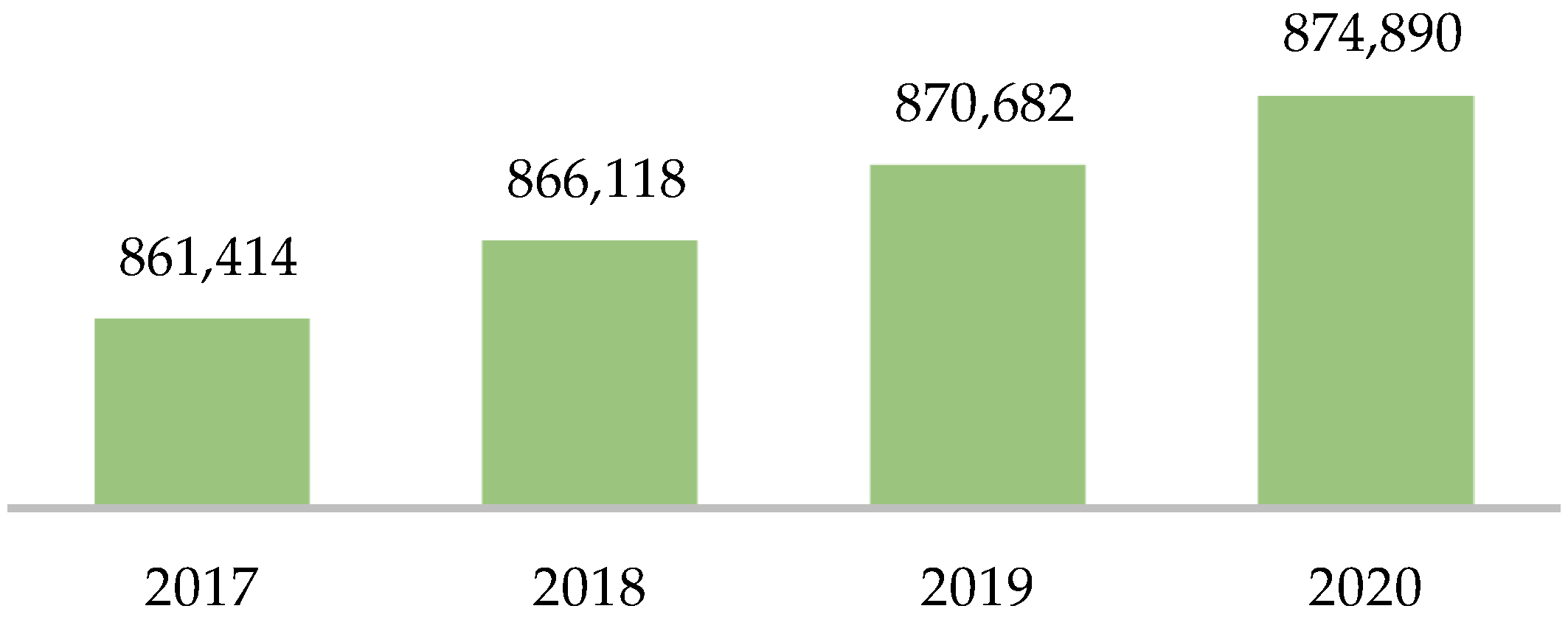
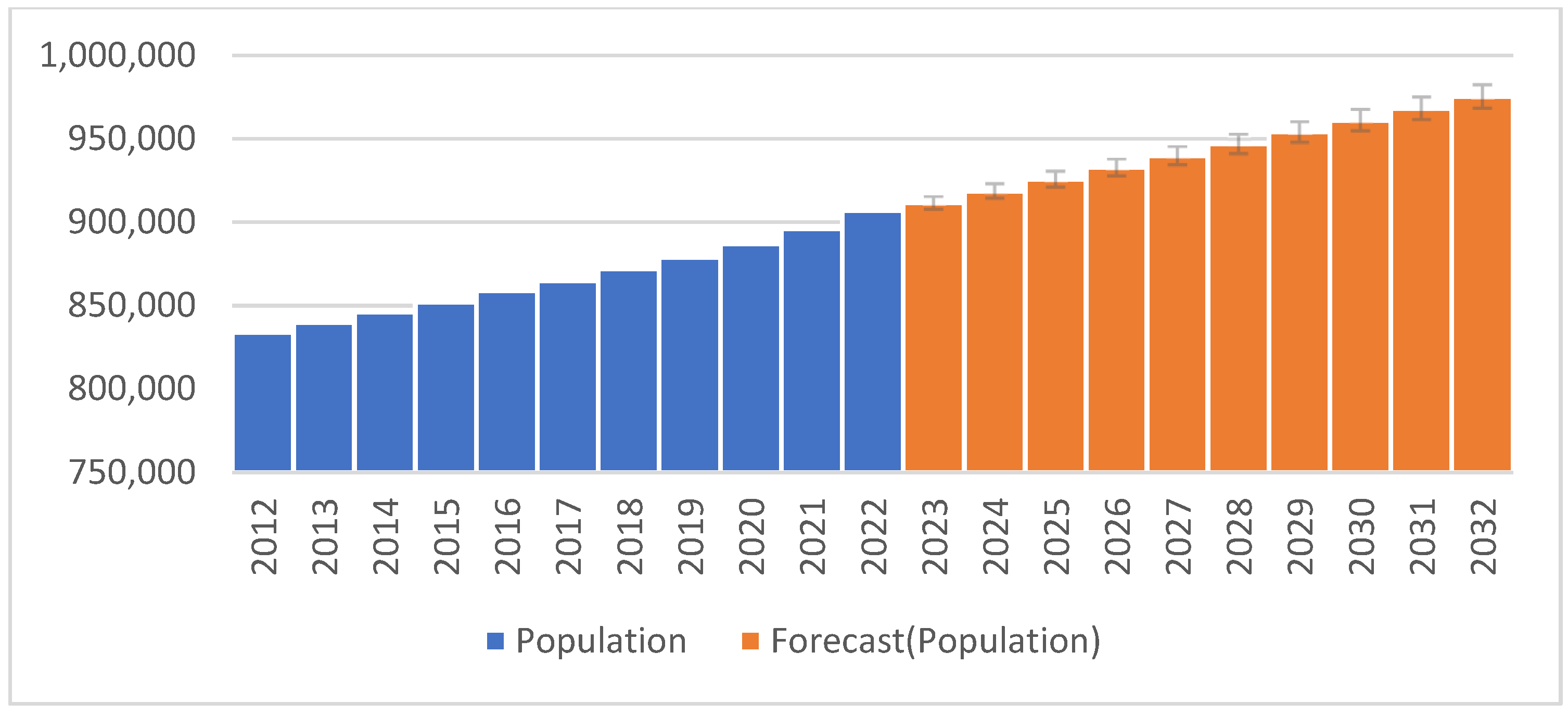
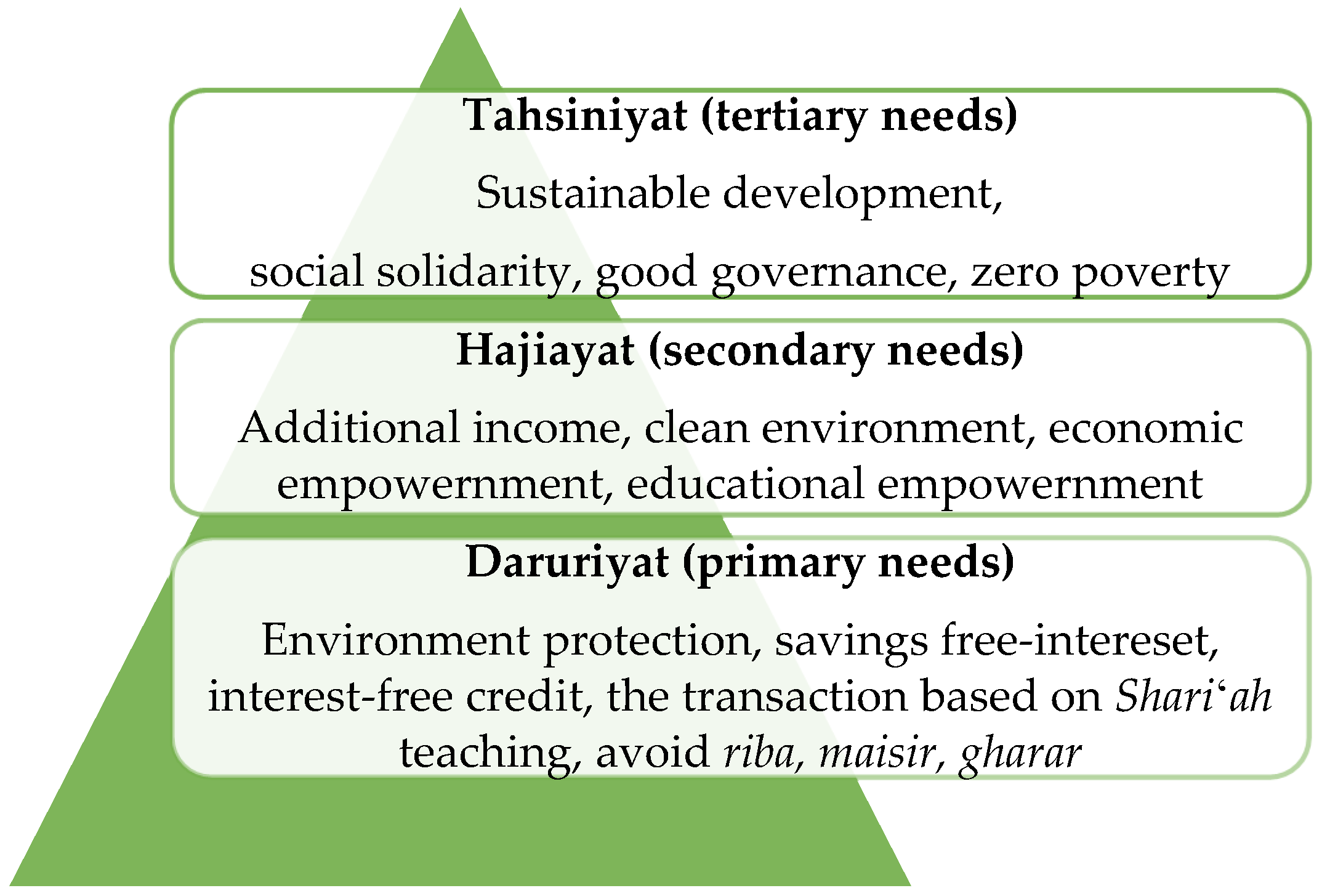
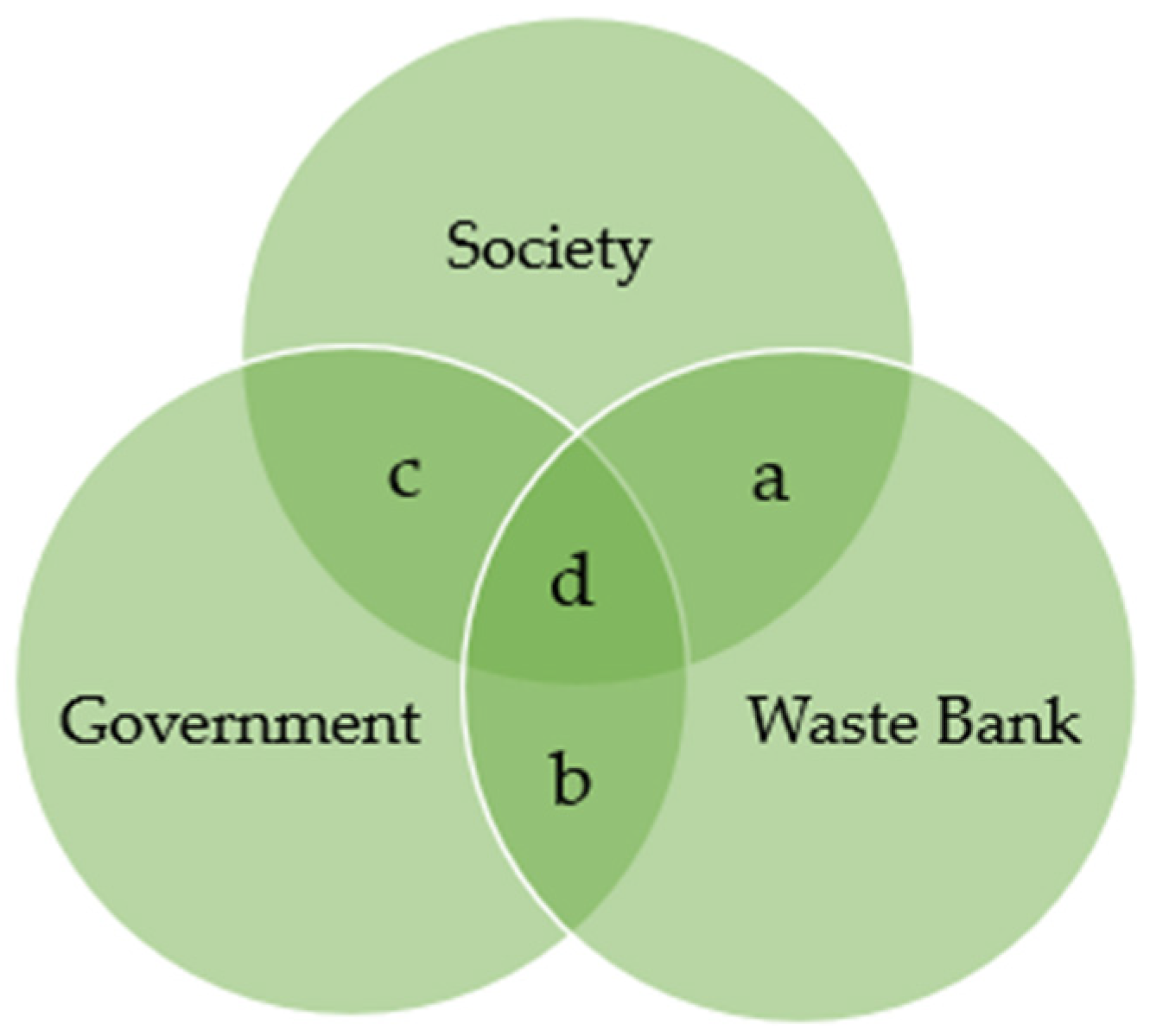
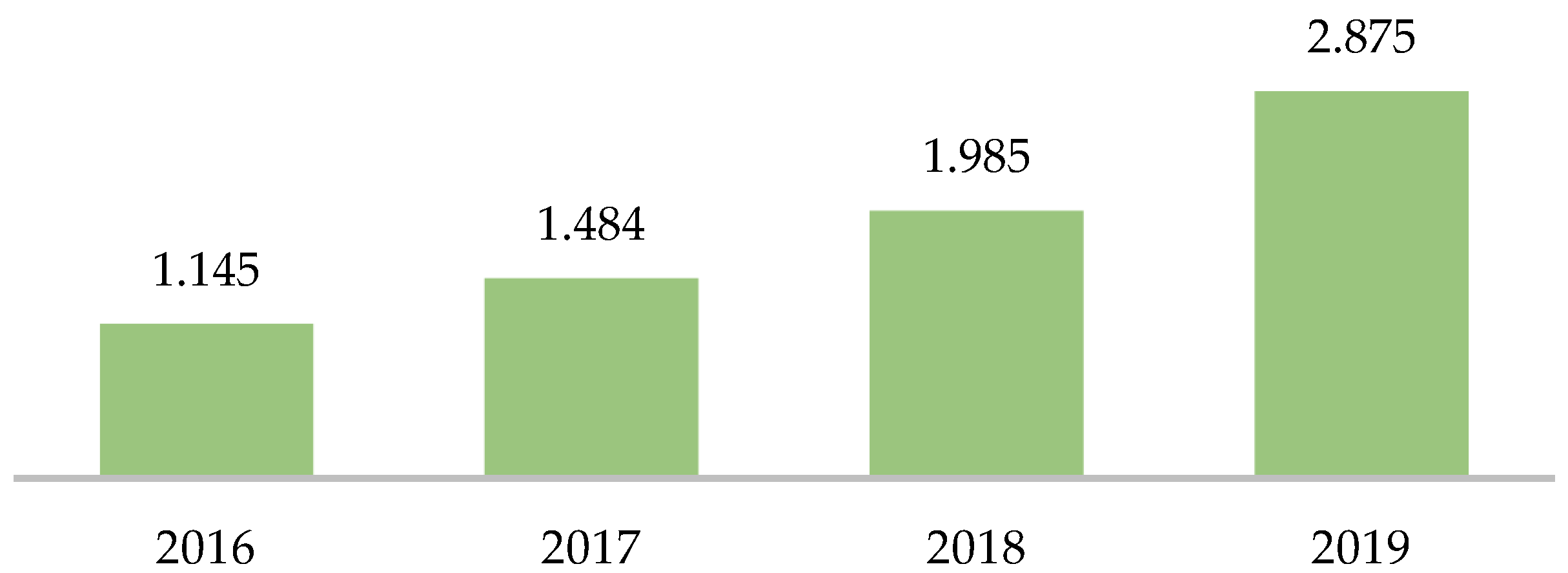
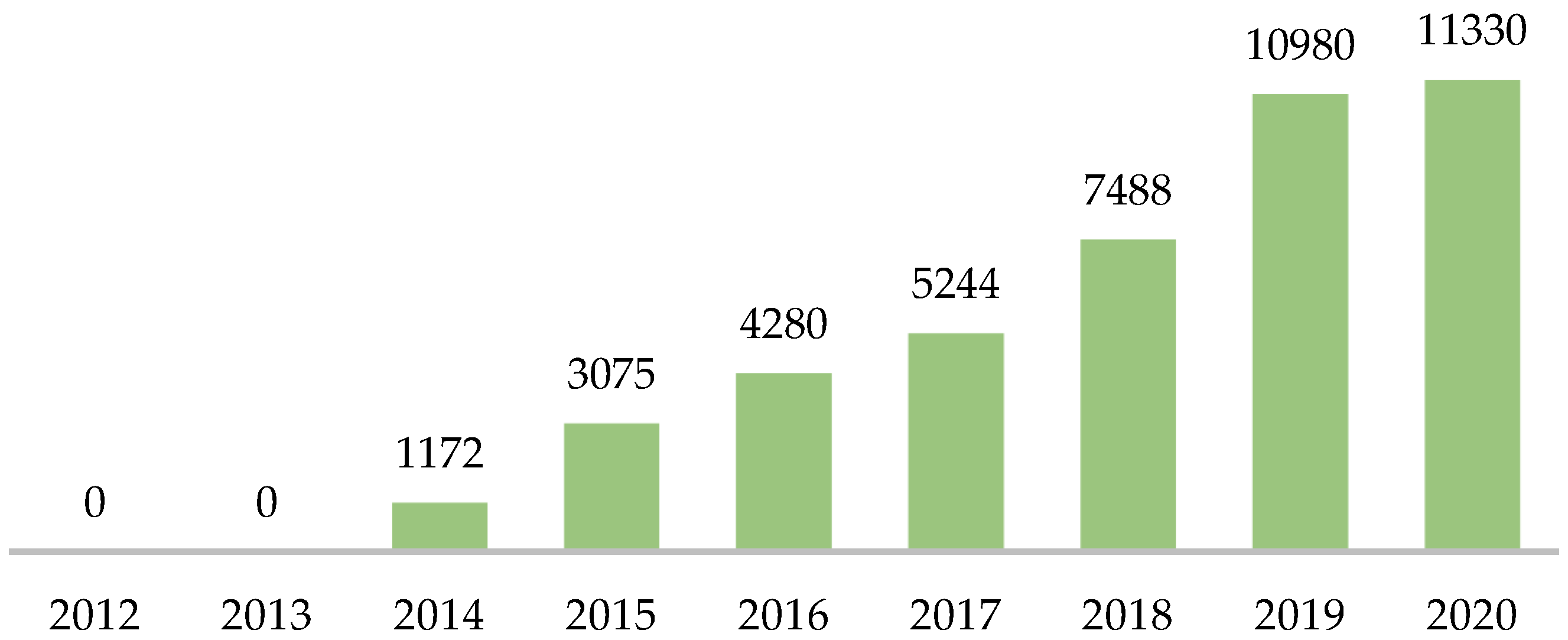
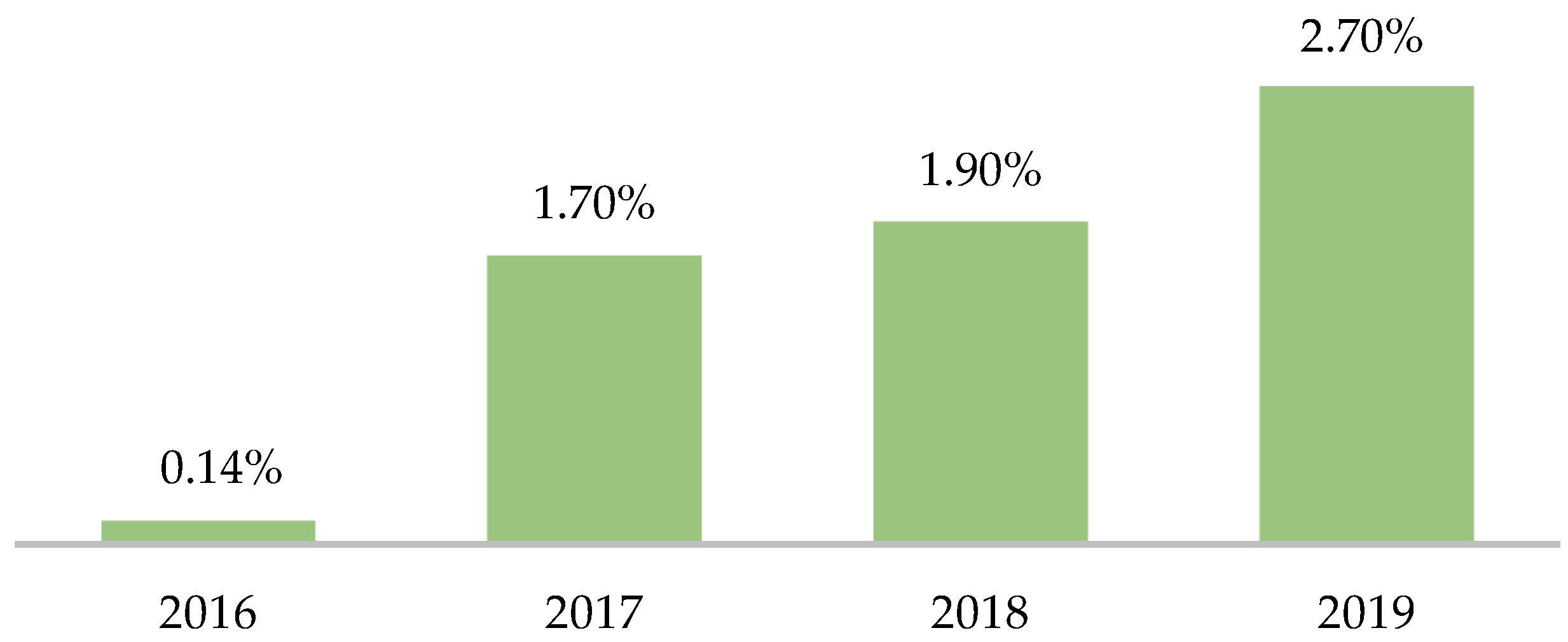
| Public Good (Maslahah) | Prevent Harm (Mafsadah) |
|---|---|
|
|
| No. | Type of Plastic | Price | No. | Type of Bottle/Glass | Price |
|---|---|---|---|---|---|
| 1 | Clear Plastic | 2.000 | 1 | Glass Bottle | 1.000 |
| 2 | Dirty Plastic | 600 | 2 | Drink Bottle | 1.000 |
| 3 | Screen Printing Plastic | 400 | 3 | Orson drink bottle | 600 |
| 4 | Thin plastic | 350 | 4 | Bottle of Soy Sauce/Big Sauce | 650 |
| 5 | Small Atum Bottle | 3.000 | 5 | Gasoline Bottle | 550 |
| 6 | Glass Bottle | 3.500 | 6 | Beer Bottle | 500 |
| 7 | Mixed Plastic | 3.500 | 7 | Coca-Cola Bottle | 200 |
| 8 | Cable Skin | 2.000 | No | Type of Copper | Price |
| 9 | Hose | 900 | 1 | Ordinary Copper | 90.000 |
| 10 | Carpet | 500 | 2 | Super Copper | 95.000 |
| 11 | Color Bottle Caps | 2.500 | No | Type of Zinc/Iron | Price |
| 12 | Clean Color Drink bottle | 3.000 | 1 | Good Zinc | 300 |
| 13 | Dirty Color Drink Bottle | 2.000 | 2 | Ordinary Zinc | 3.000 |
| No | Type of Paper | Price | 3 | Good Iron | 4.000 |
| 1 | Ordinary book | 2.500 | 4 | Ordinary Iron | 3.000 |
| 2 | HVS Paper | 2.600 | No | Type of Aluminum | Price |
| 3 | Newspaper | 2.600 | 1 | Slender Cop | 11.000 |
| 4 | Building Paper | 3.000 | 2 | Antenna/Pot/Frying Pan | 8.000 |
| 5 | Magazine | 1.000 | 3 | Plate | 12.000 |
| 6 | Duplex Printing | 900 | 4 | Aluminum Bottle Cap | 5.000 |
| 7 | Good Cardboard | 2.000 | 5 | Bronze | 9.000 |
| 8 | Bad Cardboard | 1.900 | 6 | Monel | 16.000 |
| No. | Description | 2016 | 2017 | 2018 | 2019 |
|---|---|---|---|---|---|
| Revenue | |||||
| 1 | Waste sales of the Operational Division | 1.218 | 1.486 | 1.793 | 1.901 |
| 2 | Waste sales of the Production Division | 1.100 | 1.256 | 950 | 1.174 |
| 3 | Waste sales of the Household Division | 545 | 688 | 989 | 1.790 |
| 4 | Government Grants and CSR of the Electricity Company | 110 | 276 | 388 | 550 |
| 5 | Total | 2.972 | 3.705 | 4.119 | 5.484 |
| No. | Description | 2016 | 2017 | 2018 | 2019 |
|---|---|---|---|---|---|
| Expenses | |||||
| 1 | Capital goods | 19 | 23 | 23 | 25 |
| 2 | General operating expenses | 2.766 | 2.996 | 3.312 | 4.543 |
| 3 | Total Expenditure | 2.785 | 3.019 | 3.335 | 4.569 |
Publisher’s Note: MDPI stays neutral with regard to jurisdictional claims in published maps and institutional affiliations. |
© 2022 by the authors. Licensee MDPI, Basel, Switzerland. This article is an open access article distributed under the terms and conditions of the Creative Commons Attribution (CC BY) license (https://creativecommons.org/licenses/by/4.0/).
Share and Cite
Miftahorrozi, M.; Khan, S.; Bhatti, M.I. Waste Bank-Socio-Economic Empowerment Nexus in Indonesia: The Stance of Maqasid al-Shariʻah. J. Risk Financial Manag. 2022, 15, 294. https://doi.org/10.3390/jrfm15070294
Miftahorrozi M, Khan S, Bhatti MI. Waste Bank-Socio-Economic Empowerment Nexus in Indonesia: The Stance of Maqasid al-Shariʻah. Journal of Risk and Financial Management. 2022; 15(7):294. https://doi.org/10.3390/jrfm15070294
Chicago/Turabian StyleMiftahorrozi, Miftahorrozi, Shabeer Khan, and Muhammad Ishaq Bhatti. 2022. "Waste Bank-Socio-Economic Empowerment Nexus in Indonesia: The Stance of Maqasid al-Shariʻah" Journal of Risk and Financial Management 15, no. 7: 294. https://doi.org/10.3390/jrfm15070294
APA StyleMiftahorrozi, M., Khan, S., & Bhatti, M. I. (2022). Waste Bank-Socio-Economic Empowerment Nexus in Indonesia: The Stance of Maqasid al-Shariʻah. Journal of Risk and Financial Management, 15(7), 294. https://doi.org/10.3390/jrfm15070294







